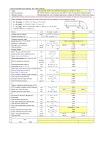Welding Defects can be defined as the irregularities formed in the given weld metal due to wrong welding process or incorrect welding patterns, etc. Some defects are caused by problems with the materials. Other welding problems may not be foreseeable and may require immediate corrective action. A poor welding technique and improper choice of welding parameters can cause weld defects.
Defects that can occur when using the shielded metal arc welding process are slag inclusions, wagon tracks, porosity, wormhole porosity, undercutting, lack of fusion, overlapping, burn through, arc strikes, craters and excessive weld spatter. Many of these welding technique problems weaken the weld and can cause cracking. Other problems that can occur and which can reduce the quality of the weld are arc blow, finger nailing and improper electrode coating moisture contents.
Defects Caused by Welding Technique
Slag inclusions occur when slag particles are trapped inside the weld metal, which produces a weaker weld. These can be caused by:
- If the welding speed is too fast then also slag may occur.
- Too wide a weaving motion.
- Slag left on the previous weld pass
- Too large an electrode being used
- Letting slag run ahead of the arc.
- A uniform travel speed
- A tighter weaving motion
- Complete slag removal before welding
- Using a smaller electrode
- Keeping the slag behind the arc, which is done by shortening the arc, increasing the travel speed or changing the electrode angle.
Wagon tracks are linear slag inclusions that run the longitudinal axis of the weld. They result from allowing the slag to run ahead of the weld puddle and by slag left on the previous weld pass. These occur at the toe lines of the previous weld bead.
3.Porosity :-
3.Porosity :-
Porosity is gas pockets in the weld metal that may be scattered in small clusters or along the entire length of the weld. Porosity weakens the weld in approximately the same way that slag inclusions do.
Porosity may be caused by:
- Excessive welding current
- Rust, grease, oil or dirt on the surface of the base metal
- Excessive moisture in the electrode coatings
- Impurities in the base metal
- Too short an arc length, except when using low-hydrogen or stainless steel electrodes
- Travel speed too high, which causes freezing of the weld puddle before gases can escape.
This problem can be prevented by:
- Lowering the welding current
- Cleaning the surface of the base metal
- Redrying electrodes
- Changing to a different base metal with a different composition
- Using a slightly longer arc length
- Lowering the travel speed to let the gases escape
- Preheating the base metal, using a different type of electrode, or both.
Wormhole porosity is the name given to elongated gas pockets. The best method of preventing this is to lower the travel speed to permit gases to escape before the weld metal freezes.
5.Undercutting :-
5.Undercutting :-
Undercutting is a groove melted in the base metal next to the toe or root of a weld that is not filled by the weld metal. Undercutting causes a weaker joint and it can cause cracking.
This defect is caused by:
- Excessive welding current too long an arc length
- Excessive weaving speed
- Excessive travel speed.
This defect can. be prevented by:
- Choosing the proper welding current for the type and size of electrode and the welding position
- Holding the arc as short as possible
- Pausing at each side of the weld bead when a weaving technique is used
- Using a travel speed slow enough so that the weld metal can completely fill all of the melted out areas of the base metal.
Lack of fusion is when the weld metal is not fused to the base metal. This can occur between the weld metal and the base metal or between passes in a multiple pass weld.
Causes of this defect can be:
- Excessive travel speed
- Electrode size too large
- Welding current too low
- Poor joint preparation
- Letting the weld metal get ahead of the arc.
Lack of fusion can usually be prevented by:
- Reducing the travel speed
- Using a smaller diameter electrode
- Increasing the welding current
- Better joint preparation
- Using a proper electrode angle.
Overlapping is the protrusion of the weld metal over the edge or toe of the weld bead. This defect can cause an area of lack of fusion and create a notch, which can lead to crack initiation.
Overlapping is often produced by:
- Too slow a travel speed, which permits the weld puddle to get ahead of the electrode
- An incorrect electrode angle.


















-page-001.jpg)

0 Comments